Custom Silicone Extrusion Molding
Unlocking the Potential of Silicone Extrusion Molding.
Start Your Silicone Extrusion Molded Parts Quote
What is Silicone Extrusion Molding?
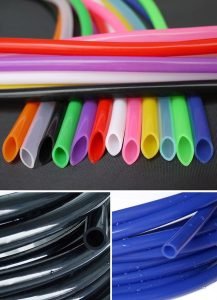
Silicone Extrusion Molding is a manufacturing process widely used to create objects of a fixed cross-sectional profile. This process involves pushing or drawing the material, in this case, silicone, through a specialized tool called a die, which forms it into the desired shape.
Heating is often used to facilitate the extrusion process, making the silicone more malleable and easier to shape. After extrusion, the silicone undergoes a curing process to harden and set the shape.
This method is commonly used in the production of a diverse range of products, including sealing strips, gaskets, silicone tubes, silicone cords, complex profiles, window seals, and more. The advantage of Silicone Extrusion Molding is that it allows for the production of long, continuous pieces with a consistent cross-section, which can be cut to specific lengths as per the requirements. This process is incredibly efficient and versatile making it beneficial for high-volume production.
Why Choose Us as your Silicone Extrusion Molding partner?
One-stop service, from review of silicone extrusion products to silicone mold manufacturing and silicone extrusion molding services, we can turn your ideas into reality as soon as possible.
Silicone Rubber Extrusion Mold Making
Silicone Rubber Extrusion Mold Making
Silicone Rubber Extrusion Tubing Manufacturing
Silicone Rubber Molding Products Packaging and shipping
Silicone Extrusion Molding Parts That We Offer
A variety of custom parts made of silicone rubber extrusion molding are processed by us for customers, from Silicone extrusion mold, low-volume production to mass production orders. There are many types of silicone extruded parts, some of the common ones include:
- Silicone tubes: They can be made into various shapes and sizes according to usage requirements, often used in medical devices, food processing, and other industrial applications.
- Silicone strips: These parts are mainly used in the construction industry, such as sealing strips for windows and doors. They’re also frequently used in various electronic devices and inside cars.
- Silicone sealing rings: Silicone sealing rings have excellent sealing performances and are widely used in various valves, pumps, and pipeline connections.
- Silicone gaskets: Silicone gaskets are mainly used in electrical appliances and electronic equipment to maintain good heat management and electrical insulation.
- Silicone insulating sleeves: These parts are mainly used in electronic wire harnesses to prevent short circuits and corrosion between wires.
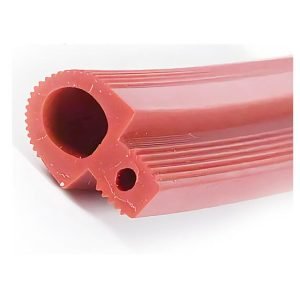
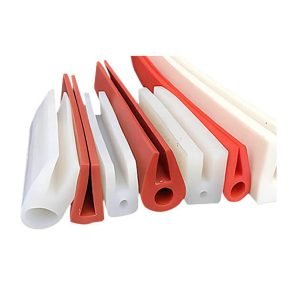
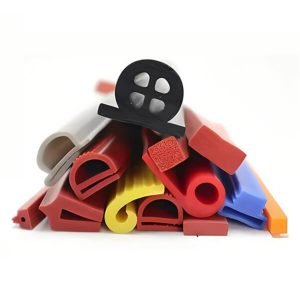
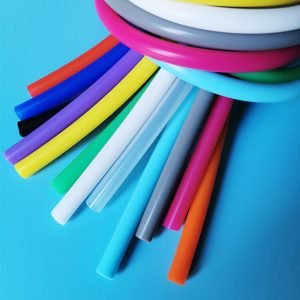
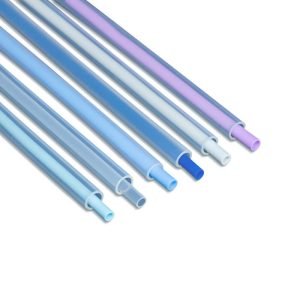
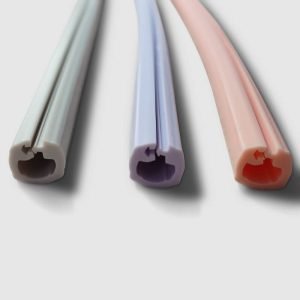

Silicone extrusion molded products are applied widely in various fields:
- Automotive Industry
- Medical Field
- Electronics Industry
- Household Appliances
- Construction Field
In car manufacturing, silicone products are used in car windows, door and window trim, fenders, and sealing pads, playing a vital role in waterproofing, dustproofing, and sound insulation for vehicles.
In medical equipment, silicone products are often used as catheters, bottle mouths, and other medical devices. Because silicone is harmless to the human body, it is broadly used in this area.
In electronic products, silicone products are mainly used as wire harness insulating sleeves, which serve as protective measures for wire harnesses. They can prevent wires from burning and short circuiting among wires.
In rice cookers, electric hot cups, electric kettles, and other home appliances, silicone products are mainly used as energy-saving insulation layers for appliances, saving energy while maintaining the appliances’ lifespan.
Frequently Asked Questions
- Flexibility in Design: Extrusion molding allows for a wide range of shapes and sizes, enabling complex and customized configurations. Since the parts are shaped by the die it passes through, virtually any consistent cross-sectional design can be made.
- High Efficiency: The extrusion process is continuous, creating long lengths that can be cut to desired sizes. This is especially useful for large-scale production runs, making it a cost-effective method.
- Material Properties: Silicone rubber is naturally resistant to extreme temperatures and environmental conditions like UV light, making the parts durable. It also possesses excellent electrical insulation properties.
- Consistency: The extrusion process can maintain high consistency and tight tolerances in cross-sectional dimensions of the parts, which is crucial in many applications.
- Rapid Prototyping: With relatively quick turnover for creating new dies, concept designs for silicone rubber parts can be turned into physical prototypes quickly, hastening the development process.
- Freedom of Material Choice: Various grades of silicone are available, allowing for extruded parts that meet exact requirements, including food grade, medical grade, high temperature silicone and more.
- Material Preparation: Silicone rubber starts out as a raw material, often in forms of granules or gum. Sometimes specific additives, such as color pigments or other formula ingredients required for the final product, are mixed in.
- Feeding the Extruder: This prepared material is then fed into the extruder. The extruder typically consists of a large, cylindrical barrel with a screw-like mechanism inside, called an auger.
- Heating and Pressurizing: As the auger turns, it conveys the silicone towards the die and simultaneously compresses and heats the material. The heat and pressure combined condition the material into a softened or semi-solid state that is appropriate for extrusion.
- Passing Through the Die: The prepared silicone is forced, or extruded, through a custom-manufactured die. The die is essentially a metal plate with one or more openings cut into it, typically shaped in the cross-section of the desired finished product.
- Shape Formation: As the silicone is extruded through the die, it takes on the shape of the die’s openings. This results in a continuous length of silicone rubber with the desired profile.
- Curing or Vulcanization: The newly formed shape is then exposed to heat in a process called curing or vulvanization. This process hardens and sets the silicone, providing it with its final physical and mechanical properties.
- Cooling and Finishing: After the curing process, the extrusions are cooled. They can then be cut into specific lengths or further processed according to the requirements of the application.
- Design Complexity: The more complex the design or the profile of the extruded part, the more expensive it will be. This is due to the higher costs of creating more complex dies and the potential need for more sophisticated machinery or handling.
- Material Selection: The type of silicone used can also affect cost. Medical-grade or specialty silicones might be more expensive than general-purpose grades.
- Quantity: Large-scale production runs will typically lower the unit cost due to economies of scale. Smaller runs may have a higher per unit cost.
- Tolerances: Tighter tolerances (the degree to which the part must exactly match the given specifications) generally increase the price due to the greater level of precision required.
- Post-processing Requirements: Any secondary operations required, such as cutting to length, adding adhesive backing, splicing, or bonding, will also add to the final cost.
- Technical Drawings: A detailed drawing or CAD model of the part showing all dimensions, tolerances, and any special features.
- Material Specifications: Your specifications for the silicone material, such as grade, color, hardness, etc.
- Quantity: The number of parts you need to be produced.
- Expected Delivery Date: Your timeline for the production and delivery of the parts.
- Any Additional Requirements: Anything else the manufacturer should know to produce your part, such as post-processing or packaging requirements.
- Design Requirements: The nature and specifications of the final application can heavily influence the necessary tolerances. For instance, if the part has to interface precisely with other parts or systems, a tighter tolerance may be needed to ensure a proper fit and function.
- Material Behavior: Different grades of silicone behave differently under heat, pressure, and during the curing process. Some materials might shrink or expand more than others, which must be considered when defining the tolerances.
- Extrusion Process Capabilities: The equipment’s capabilities and any inherent variations in the extrusion process can limit the possible tolerances. Extrusion machinery with higher precision and control can achieve tighter tolerances, but may also increase production costs.
- Complexity of the Cross-Section: More complex profiles might be more difficult to extrude consistently, requiring wider tolerances. Simpler shapes, on the other hand, can generally be made to tighter specifications.
- Post Extrusion Processes: Some finishes or post-extrusion processes can distort the profile or dimensions of the part, and this must be considered when defining tolerances.
- Cost Considerations: Tighter tolerances often require more process control, more sophisticated machinery, or additional steps in manufacturing, all of which can lead to higher costs.
- Material Selection and Mixing: The ability to offer a broad range of silicone materials and to execute specific mixes as required by customers, such as adding colors or specific components.
- Design and Engineering Capabilities: A design and engineering team to assist in creating complex extrusion molds and to solve any technical issues that may arise during the extrusion process.
- Extrusion Capabilities: Advanced extrusion equipment and process control to accommodate a variety of extrusion requirements of different specifications and complexities.
- Tolerance Control: The ability to guarantee extremely precise dimensions and tolerances, especially for applications that must conform to strict specifications.
- Curing and Post-processing: The factory needs to have the appropriate equipment and processes for curing or vulcanizing, as well as any necessary post-processing operations such as cutting, grinding, bonding, or surface treatments.
- Quality Control: Comprehensive quality control processes to ensure the product meets all specification requirements and quality standards.
- Scale and Flexibility: The ability to handle large-scale production runs, yet also flexible enough to cater to small batches and custom requirements.
- Delivery and Logistics: Reliable delivery and logistics solution to ensure on-time, quality delivery.